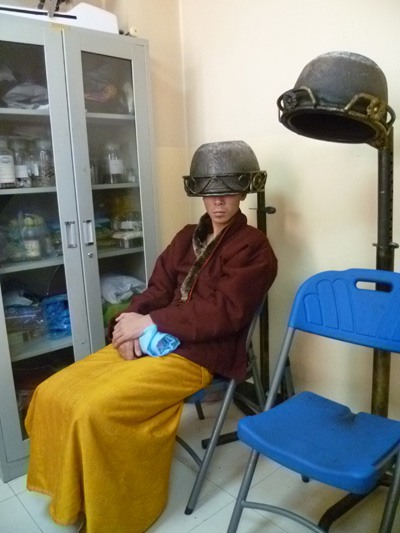|
 |
|
TREATMENT IN COMFORT: The traditional therapy shown is used to improve blood supply to the head (PAN XIAOQIAO) |
Tibetan medicine is especially unique in its approach to psychiatric therapy. A patient's mentality is analyzed in accordance with Tibetan medical theory, which is able to offer its own explanation of all kinds of mental and psychological problems. By introducing in Buddhist concepts like meditation and visualization, it provides a means to help patients with mental illnesses recover through self-treatment.
Before he was a teacher at Qinghai University, Kunchok Gyaltsen had already received a doctorate in public health from the University of California, Los Angeles. During his 14 years' of academic experience abroad, he retained his identity as a lama.
"When talking about science, many professors in the West suggest that religion is opposed to science, but I don't think so. The religion I believe in, Tibetan Buddhism, is quite different from what they understand as religion. Tibetan Buddhism is extremely logical, and you'll find in the process of learning Tibetan medicine how perfectly it combines the body and the soul. This combination is not just imagined as some might argue, but is the result of logical and reasonable deduction," Kunchok Gyaltsen said.
According to Kunchok Gyaltsen, Buddhism exists to improve people's mentality or their soul, while medicine mainly targets people's physical health. He said that Tibetan Buddhism has its own philosophy, and that it goes deep into human beings' sentiments and mentality. Under this philosophy, people's sentiments and mentality can also be anatomized, just as the human body can.
Western psychology only touches on people's sentiments, but Tibetan Buddhism suggests that sentiments are not equal to a person's soul or their mentality itself, Kunchok Gyaltsen argued.
Challenges and prospects
Tibetan medicine is quite popular in Qinghai, and around 180 Tibetan medicines have been covered by the province's basic medical insurance scheme. But it's difficult to apply such a policy nationwide. Currently, there are only a very limited number of Tibetan medicines listed in China's Pharmacopoeia, the highest criterion of the country's pharmaceutical management standard. As a result, many Tibetan medicines are unavailable in drugstores in most areas of China.
There is another great challenge facing Tibetan medicine as well as traditional Chinese medicine. For thousands of years, Tibetan medicine has been an integrated subject. Students learn everything from one teacher, who has a deep knowledge of every single part of Tibetan medicine, which is in sharp contrast to the Western medical system where a student of rhinology may know nothing about cardiovascular diseases. However, nowadays, the trend in Chinese medical colleges is to divide integral and comprehensive traditional medical system into different parts in the way Western medicine does.
"Tibetan medicine is both cultural and scientific in its nature. If this integration is broken and only the scientific content is preserved while the cultural part is omitted, then Tibetan medicine is no longer what it is now, as it will have lost its soul. It will not be as effective", Kunchok Gyaltsen said.
Local people, who understand the significance of Tibetan medicine, tend to choose to go to Tso-Ngon Hospital when they are ill. In recent years, the hospital has also received more and more patients from China's neighboring countries including Russia, Japan and South Korea.
"Throughout history, Tibetan medicine has already developed into a comprehensive and complete medical system. Even without any external factors or help, this system is totally able to support itself," Kunchok Gyaltsen said. "In many cases where science fails human beings, I think maybe there should be kind of alternatives or supplements to science, so as to fulfill people's medical or even spiritual demands. I think Tibetan medicine is able to do so."
Email us at: panxiaoqiao@bjreview.com | 